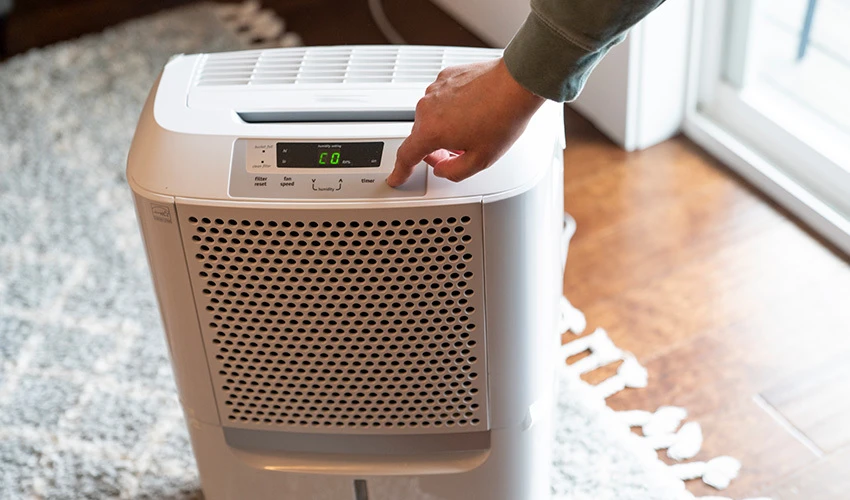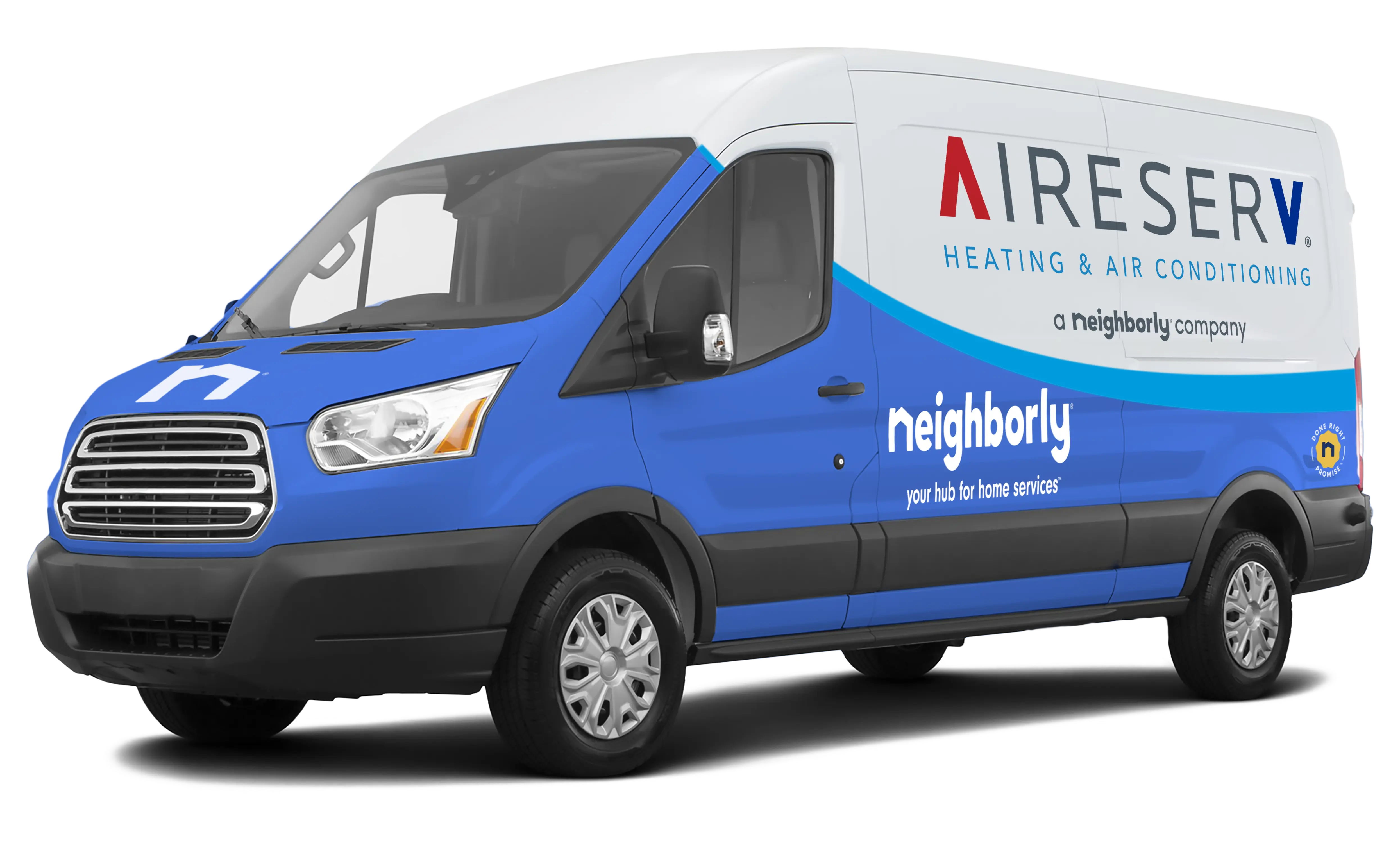
Aire Serv experts recommend how to set your dehumidifier for optimal comfort and efficiency.
- Set humidity between 30-50% for most homes
- Adjust based on season and local climate
- Use a hygrometer to monitor levels
- Empty and clean the dehumidifier regularly
- Ensure proper room ventilation
If your home feels humid or sticky, a dehumidifier can improve indoor air quality and enhance comfort, but it's important to get the humidity settings right to experience the benefits.
Not sure how to determine which setting is right for your home? We’ve got you covered with our guide to achieving the perfect humidity setting for any room, so you can get the most out of your dehumidifier.
Dehumidifier Humidity Settings: What Are They and Why Do They Matter?
The first step to determining the proper dehumidifier setting is understanding how your dehumidifier works. Dehumidifiers operate by removing water vapor from the air to keep your room dry. A fan draws in and traps moist air from a room, and coils inside the humidifier work to cool down the air. This process causes the moisture in the air to condense into water droplets that the dehumidifier collects in a bucket or drain hose. Then, the dry air is released back into the room. In this manner, dehumidifiers help regulate the moisture levels in a room.
The humidity setting that you should select depends on the humidity level of the room where the dehumidifier is located. In rooms that have high levels of moisture and humidity, such as basements, a dehumidifier will help regulate the humidity level to prevent mold and other bacterial growth. Your dehumidifier’s specific setting is important because if it is not set appropriately, your room may remain muggy or become too dry.
Optimal Dehumidifier Humidity Setting
So, what is the best humidity setting for a dehumidifier? To prevent mold growth and keep your home’s relative humidity at a comfortable level, we recommend aiming for 30%-50% humidity in your home. Ideally, that should equate to a dehumidifier humidity setting of around 40%, but you may wish to adjust it up or down to find the humidity level that feels most comfortable for your space and your household.
Now, you might be wondering: How do I check the current level of humidity in my room to make sure it is within the acceptable humidity range? Many dehumidifiers can read the current humidity level in a room automatically. If your humidifier is not equipped with a built-in humidity reading, you can purchase a standalone hygrometer.
How to Set Humidity on Dehumidifier
Setting the humidity level on your dehumidifier should be straightforward. Simply locate the humidity control buttons or dial. These should be labeled something like “Humidity Level” or “Dryness Setting” and use those buttons or dial to adjust the humidity level to your desired humidity.
Newer models will allow you to select a humidity percentage, while older ones may be more vague in their design. Should you have an older model, you may have to experiment with the settings low, medium, high, or a numbered scale to land on the right humidity level for your space.
Choose Aire Serv for all Your Dehumidifier Needs
Remember, relative humidity is a moving target. The weather, indoor and outdoor air temperature, even the amount of ventilation in your home has an impact on your home’s humidity level. If you’re having trouble striking the right balance for your home, your local Aire Serv® is here to help.
Work with Aire Serv to find the right portable or whole-house dehumidifier for your home. Our technicians are equipped to determine a baseline for humidity in your home and help you find your optimal settings. Call or request an appointment online to get started.
This article is intended for general informational purposes only and may not be applicable to every situation. You are responsible for determining the proper course of action for your home and property. Aire Serv is not responsible for any damages that occur as a result of this blog content or your actions. For the most accurate guidance, contact the Aire Serv location nearest you for a comprehensive, on-site assessment.
FAQs About Dehumidifiers
As an industry leader and a brand that is trusted by homeowners and businesses nationwide for our knowledge and experience, we’re happy to answer your HVAC questions. Here are answers to some of the frequently asked questions about the best settings for a dehumidifier.
How do dehumidifiers work?
The science behind a dehumidifier involves removing excess moisture from the air, primarily through condensation, though there are other methods. The two primary types are refrigerant and desiccant dehumidifiers.
- Refrigerant dehumidifiers: The most common type, refrigerant dehumidifiers operate on a principle similar to air conditioners. Moisture-heavy air is pulled in and passes over a cooling agent, causing the moisture to condense.
- Desiccant dehumidifiers: These units use a moisture-absorbing material (desiccant) to trap water vapor. The desiccant is then heated to release the moisture, which is collected as water. These are often more effective at lower temperatures.
Understanding how your unit works can help you determine which dehumidifier percentage settings work best for your home or business.
What should I set my dehumidifier at?
The ideal relative humidity (RH) level for most homes is between 30% and 50%. This range is generally considered comfortable and helps prevent issues like mold growth, dust mite proliferation, and damage to your home.
- Initial use: When using a dehumidifier in a humid space for the first time, set it to a lower humidity level, around 30% to 40%, to dry the air more quickly.
- Maintenance: Once the desired humidity is reached, set the dehumidifier to maintain a level between 40% and 50%. Most dehumidifiers have a humidistat that allows you to set a target humidity level. The unit will automatically turn on and off to maintain this setting.
Monitor the humidity levels in your home using a hygrometer and adjust the dehumidifier setting accordingly to stay within the optimal range. Setting it too low can make the air too dry and uncomfortable, while setting it too high won't effectively combat excess moisture.
Read our Ultimate Dehumidifier Maintenance Checklist for expert tips to keep your unit working effectively and efficiently.
What is the right dehumidifier setting to prevent mold?
To effectively prevent mold growth, set your dehumidifier to maintain a relative humidity level between 30% and 50%. This range inhibits mold from thriving while also preventing the air from becoming excessively dry.
In a damp environment, set the dehumidifier to a lower setting between 30% and 40% initially to reduce the existing moisture. Once the humidity is within the 30% to 50% range, adjust the setting to maintain this level.
The dehumidifier's built-in humidistat is the most efficient way to achieve a consistent level for fighting mold growth. Set your target humidity, and the unit will automatically cycle on and off to stay within that range. Regularly monitor the humidity with a hygrometer to verify the settings are effective.
What do the numbers mean on a dehumidifier?
The numbers on a dehumidifier typically represent the target relative humidity (RH) level you want to achieve in the room. Relative humidity is the percentage of water vapor present in the air compared to the maximum amount the air can hold at a given temperature.
For example, when you set the dehumidifier set point to 50, you're telling the unit to run until the relative humidity in the room reaches 50%. Once this level is achieved, the dehumidifier's humidistat will usually turn the unit off. It will then turn back on if the humidity rises above the set point.
Lower numbers indicate a drier environment, while higher numbers indicate more moisture in the air. Some older models might use a numbered scale (e.g., 1–10 or low/medium/high). In these cases, consult the manual to understand the corresponding humidity levels.
What temperature should a dehumidifier be set at?
Most standard refrigerant dehumidifiers don't have a user-adjustable temperature setting. Unlike a thermostat that controls heating or cooling, a dehumidifier’s primary function is to remove moisture, and the cooling process is inherent to its operation.
However, dehumidifiers do have optimal temperature ranges, typically between 65°F and 90°F (around 18°C to 32°C). They are less efficient in colder temperatures because the coils may ice up, hindering moisture condensation, although advanced models may have features like automatic defrost to address this.
Therefore, you don't set a temperature; instead, the ambient room temperature affects the dehumidifier's performance. Ensure your room temperature is within the recommended operating range for optimal moisture removal.
What is the best dehumidifier setting in summer?
In summer, the best dehumidifier setting to balance comfort and mold prevention is typically between 40% and 50% relative humidity. Higher humidity levels in summer can feel sticky and promote mold growth. Aiming for this range helps remove excess moisture without over-drying the air.
For even more effective humidity control in the summer, consider a whole-house residential dehumidifier.
What should I set my dehumidifier at in my basement?
The best basement dehumidifier setting to prevent mold is between 40% and 50% relative humidity. Since basements tend to be cooler, more humid, and more prone to moisture issues than other areas, maintaining this range helps inhibit mold growth effectively.
Why is controlling humidity important?
Maintaining the right humidity level with a residential or commercial dehumidifier is important for several reasons:
- Comfort: High humidity can make the air feel heavy and sticky, creating an uncomfortable environment and hindering the evaporation of sweat. Low humidity can lead to dry skin, irritated sinuses, and chapped lips.
- Health: Excess moisture promotes the growth of mold, mildew, dust mites, and other allergens that can trigger respiratory issues and allergies. Conversely, very dry air can exacerbate asthma and bronchitis.
- Property protection: High humidity can damage wooden furniture, floors, and musical instruments, leading to warping, swelling, and rot. It can also cause condensation on windows and walls, which can foster mold growth.

